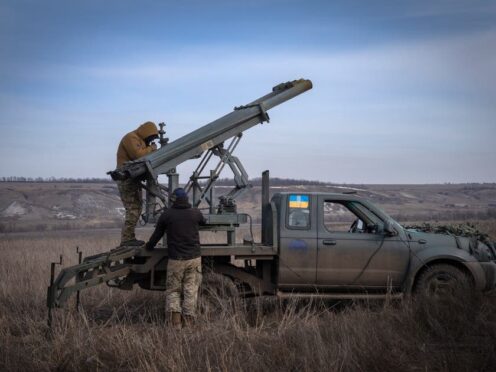The Pentagon will rush about 300 million dollars (£235 million) in weapons to Ukraine after finding some cost savings in its contracts, US defence officials said.
The move comes even though the military remains deeply overdrawn and needs at least 10 billion dollars to replenish all the weapons it has pulled from its stocks to help Kyiv in its desperate fight against Russia.
It is the Pentagon’s first announced security package for Ukraine since December, when it acknowledged it was out of replenishment funds. It was not until recent days that officials publicly acknowledged they were not just out of replenishment funds, but 10 billion dollars overdrawn.
The replenishment funds have allowed the Pentagon to pull existing munitions, air defence systems and other weapons from its reserve inventories under presidential drawdown authority, or PDA, to send to Ukraine and then put contracts on order to replace those weapons.
One of the senior defence officials who briefed reporters said the package represented a “one-time shot” — unless Congress passes a stalled supplemental spending bill that includes roughly 60 billion dollars in military aid for Ukraine, or more cost savings are found.
It is expected to include anti-aircraft missiles, artillery rounds and armour systems, the official said.

The aid announcement comes as Polish leaders are in Washington to press the US to break its impasse over replenishing funds for Ukraine at a critical moment in the war.
Polish President Andrzej Duda met with Democratic and Republican leaders in the House and Senate and was to meet with President Joe Biden later in the day.
House Speaker Mike Johnson has so far refused to bring the 95 billion dollars package, which includes aid for Ukraine, Israel and Taiwan, to the floor.
Seeking to put pressure on the Republican speaker, House Democrats have launched a long-shot effort to force a vote through a discharge petition. The seldom-successful procedure would require support from a majority of lawmakers, or 218 members, to move the aid package to a vote.
Ukraine’s situation has become more dire, with units on the front line rationing munitions as they face a vastly better supplied Russian force.
Ukrainian President Volodymyr Zelensky has repeatedly implored Congress for help, but House Republican leadership has not been willing to bring the Ukraine aid to the floor for a vote, saying any aid must first address border security needs.

Pentagon officials said on Monday during budget briefing talks they were counting on the supplemental to cover the 10 billion dollars replenishment hole.
“If we don’t get the 10 billion dollars we would have to find other means,” Deputy Defence Secretary Kathleen Hicks said.
“Right now we’re very much focused on the need for that supplemental.”
The senior defence officials who briefed reporters said the Pentagon was able to get cost savings of roughly 300 million dollars in earlier Ukraine contracts and, given the battlefield situation, decided to use those savings to go ahead and send more weapons.
This is the second time in less than nine months that the Pentagon has “found” money to use for additional weapons shipments to Ukraine.
Last June, defence officials said they had overestimated the value of the weapons the US had sent to Ukraine by 6.2 billion dollars over the past two years.
At the time, Pentagon officials said a review found that the military services used replacement costs rather than the book value of equipment that was pulled from Pentagon stocks and sent to Ukraine.
The discovery resulted in a surplus that the department used for presidential drawdown packages until the end of December.
The United States has committed more than 44.9 billion dollars in security assistance to Ukraine since the beginning of the Biden administration, including more than 44.2 billion dollars since the beginning of Russia’s invasion on February 24, 2022.
The Pentagon is 10 billion dollars overdrawn in the replenishment account in part due to inflationary pressures, and in part because the new systems the Pentagon is seeking to replace the old systems with cost more, such as the upcoming Precision Strike Missile, or PrSM, which the Army is buying to replace the long-range Army Tactical Missile System, or ATACMS.
The vast majority of those munitions have come from Army stockpiles due to the nature of the conventional land war in Ukraine.
The months without further shipments of US support have hurt operations, and Ukrainian troops withdrew from the eastern city of Avdiivka last month, where outnumbered defenders had withheld a Russian assault for four months.
CIA director William Burns told Congress that entire Ukrainian units have told him in recent days of being down to their last few dozen artillery shells and other ammunition.
Mr Burns called the retreat from Avdiivka a failure of ammunition resupply, not a failure of Ukrainian will.
